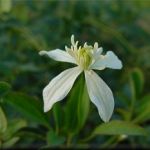| Common Name: |
Chinese Clematis |
| Botanical Name: |
Clematis chinensis |
| Genus: |
Clematis |
| Family: |
Ranunculaceae |
| Native Location: |
C and W China |
| Cultivation: |
Well-drained neutral to alkaline soil in sun, with roots in shade. In spring, cut back shoots and dead stems after flowering. Plants may suffer from powdery mildew and clematis wilt. |
| Propagation: |
By seed sown when ripe; by softwood cuttings in spring, or semi-ripe cuttings in early summer. |
| Harvest: |
Roots are lifted in autumn and dried for use in decoctions. |
| Height: |
8m (25ft) |
| Width: |
8m (25ft) |
| Hardiness: |
Z6 |
| Parts Used: |
Roots (wei ling xian) |
| Properties: |
A pungent, warming herb that has painkilling, sedative, and diuretic effects, lowering fever and relieving spasms. |
| Medicinal Uses: |
Internally for rheumatism and arthritis, usually taken in wine. A decoction in rice vinegar is a traditional remedy for dissolving fish bones lodged in the throat. |
| Warning: |
Harmful if eaten, Mild skin irritant. |
| Bibliography: |
Encylopedia of Herbs by Deni Brown Copyright ©: 1995, 2001 Dorling Kindersley Limited pg. 173
|

